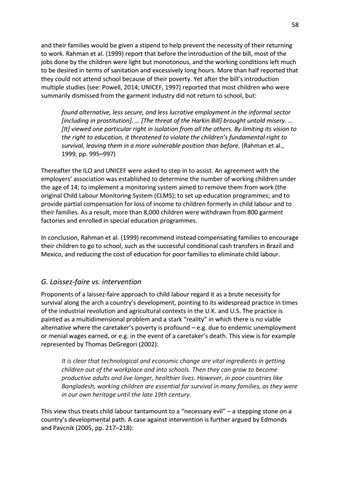58 and their families would be given a stipend to help prevent the necessity of their returning to work. Rahman et al. (1999) report that before the introduction of the bill, most of the jobs done by the children were light but monotonous, and the working conditions left much to be desired in terms of sanitation and excessively long hours. More than half reported that they could not attend school because of their poverty. Yet after the bill’s introduction multiple studies (see: Powell, 2014; UNICEF, 1997) reported that most children who were summarily dismissed from the garment industry did not return to school, but: found alternative, less secure, and less lucrative employment in the informal sector [including in prostitution]. … [The threat of the Harkin Bill] brought untold misery. … [It] viewed one particular right in isolation from all the others. By limiting its vision to the right to education, it threatened to violate the children’s fundamental right to survival, leaving them in a more vulnerable position than before. (Rahman et al., 1999, pp. 995–997) Thereafter the ILO and UNICEF were asked to step in to assist. An agreement with the employers’ association was established to determine the number of working children under the age of 14; to implement a monitoring system aimed to remove them from work (the original Child Labour Monitoring System (CLMS); to set up education programmes; and to provide partial compensation for loss of income to children formerly in child labour and to their families. As a result, more than 8,000 children were withdrawn from 800 garment factories and enrolled in special education programmes. In conclusion, Rahman et al. (1999) recommend instead compensating families to encourage their children to go to school, such as the successful conditional cash transfers in Brazil and Mexico, and reducing the cost of education for poor families to eliminate child labour.
G. Laissez-faire vs. intervention Proponents of a laissez-faire approach to child labour regard it as a brute necessity for survival along the arch a country’s development, pointing to its widespread practice in times of the industrial revolution and agricultural contexts in the U.K. and U.S. The practice is painted as a multidimensional problem and a stark “reality” in which there is no viable alternative where the caretaker’s poverty is profound – e.g. due to endemic unemployment or menial wages earned, or e.g. in the event of a caretaker’s death. This view is for example represented by Thomas DeGregori (2002): It is clear that technological and economic change are vital ingredients in getting children out of the workplace and into schools. Then they can grow to become productive adults and live longer, healthier lives. However, in poor countries like Bangladesh, working children are essential for survival in many families, as they were in our own heritage until the late 19th century. This view thus treats child labour tantamount to a “necessary evil” – a stepping stone on a country’s developmental path. A case against intervention is further argued by Edmonds and Pavcnik (2005, pp. 217–218):













